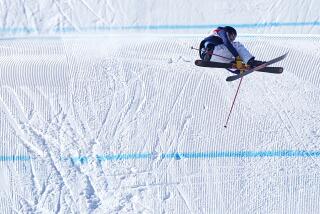Skiing’s on the Way Up in China
- Share via
MIYUN, China — They avoid the dangerous runs and crowd the bunny slopes, edging their way downhill as they enjoy something that didn’t exist in China a decade ago: the ski holiday.
“Chinese families like to do things together, but I didn’t want to go shopping again,” said Zhang Fanyun, a schoolteacher watching his daughter and son-in-law ski. “Skiing is a new, fresh thing.”
Each weekend, thousands crowd Nanshan Ski Village, built outside Beijing to serve newly prosperous city dwellers who have taken to the pricey sport in recent years.
Instead of hot chocolate, the ski lodge serves green tea and broiled pork. In the parking lot, a vendor sells a good, greasy meal of egg-filled crepes with scallions and hot sauce.
“Ten years ago, only 500 people in China could ski, and they were all professional athletes,” said Lu Jian, an Oxford-trained economist who founded Nanshan after being inspired by a visit to the U.S. ski haven of Vail, Colo. “This year, 5 million Chinese people will visit ski resorts. You can say this represents the new China.”
There are now more than 200 ski resorts in the country, up from none a decade ago. Lu opened the first in 1995 in Heilongjiang province in the far northeast. But while frigid Heilongjiang has the snow, Beijing has the money, so he opened Nanshan in 2001, with machines providing snow that nature often won’t.
“I felt that China lacked this sort of facility,” he said. “So I read a lot of books on how to build a ski facility.”
The resort is an eye-catching oasis of white amid the parched brown hills.
Zhang, the teacher, had come with his wife from their hometown in central China to visit their daughter and her husband, both professionals in Beijing.
“I don’t dare ski myself because I’m afraid I’d fall,” said Zhang, whose job this day was to hold all the family cameras and keep track of locker keys.
“While the children ski, my wife and I will ride in the chairlift and enjoy the fresh air and scenery,” he said. “This is something we can all do together.”
A four-hour lift ticket plus equipment rental at Nanshan costs $24 -- more than a week’s wages for the average urban worker and pricey even for the engineers, stockbrokers and other professionals on the slope.
Since few own ski clothes, the resort rents parkas along with skis and poles. As a result, nearly everyone wears matching purple -- an echo of the decades when the masses all wore the same drab green Mao jacket and cloth cap.
And because this is chain-smoking China, men make their way down the slopes with cigarettes clenched in their mouths.
The skiers may lack in skill, but not enthusiasm.
“My son is good at ice skating, so I figured he could do this as well,” said Huang Chun, who also brought his nephew. “The boys were very excited, but they refused to take lessons. I said we should research the situation, and they said, no, they wanted to ski right away.”
His nephew, Zhao Conglong, 11, had little time for small talk.
“I did fall the first time, but not after that. It’s fun, satisfying and stimulating,” he said before hurtling down the kiddie slope in search of his cousin.
Lu, the founder, made his money in the early 1990s trading commodities futures in Chicago for a Chinese state company.
He said he sensed that as his homeland’s economy grew, it would follow the example of neighboring South Korea and skiing would take off. But his biggest boon came when China switched from a six-day to a five-day workweek in 1995.
“All of a sudden, everyone had a two-day weekend,” he said. “Two days off! With nothing to do!”
Like many Chinese entrepreneurs, Lu raised capital from relatives and friends, who in his case included other Chinese who studied in Britain at Oxford or Cambridge.
He’s also a Communist Party member, which in China brings influence that can help a small businessman.
Nanshan cost $6 million to build and had yet to recoup that investment, but Lu said the resort was making money.
And he has big plans. He envisions opening motels and time-share villas when people start taking extended ski vacations instead of just buying two- or four-hour passes.
“My goal,” he said, “is to create another Vail.”
More to Read
Sign up for The Wild
We’ll help you find the best places to hike, bike and run, as well as the perfect silent spots for meditation and yoga.
You may occasionally receive promotional content from the Los Angeles Times.






